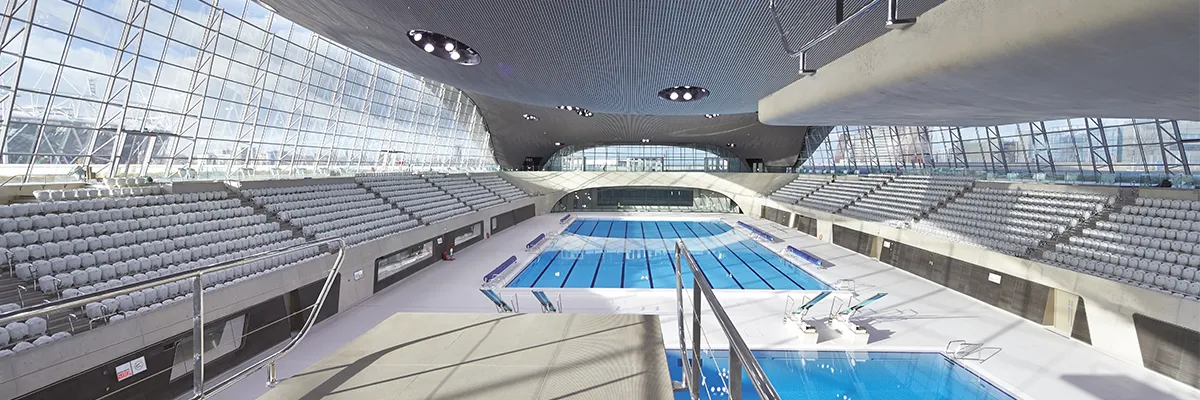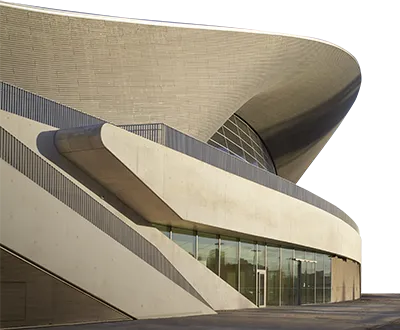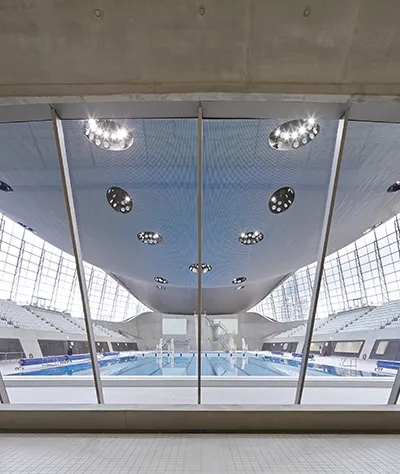THE HIGH DIVE
The late Iraqi-British architect Zaha Hadid, winner of the prestigious Pritzker prize in 2004, gave the capital what must be the most magnificent public swimming pool ever built. A visionary concept, inspired by the fluid geometry of water in motion, the London Aquatics Centre has been boldly making waves since 2012.

The 36,000 m2 of this extraordinary Aquatics Centre encloses two 50-meter pools and one 25-meter pool, overlooked by six sleek diving boards all open to users. There are a total of 2,500 seats on either side for swimming competition fans.
The centre's signature feature? Its roof: vast, vertiginous, designed as a giant undulating wave.
Originally built to host the international sporting competition of 2012, these pools, so appreciated by local residents, were designed to last from the very beginning. Director of Zaha Hadid Architects, Jim Heverin, who led the project, shares his valuable insights with us below.

How did the London Aquatics Centre successfully transition to opening to the public? What structural changes were necessary, and were the forecasts in this regard accurate to reality?
Jim Heverin, Director of Zaha Hadid Architects: The transition was quite smooth, as having a transition was a core design consideration from the beginning. The majority of seats for the
Olympic games were designed to be demountable and they were taken away after the Games. No structural changes were required as reducing the venue size and repurposing it for community
use was designed in, and provisions were made for all of the necessary changes to open it as a venue for the public. Since its opening to the public after the Games, it has established itself as
the most popular and used Olympic venue by the public for all sorts of swimming and diving.
The architectural approach of the London Aquatics Centre is unique. How was it conceived to ensure that, years later, it remains in harmony with its surroundings?
J. H.: The concept was a pavilion in a parkland setting. The roof was designed to ‘float’ over a base so it creates views in and out to nature both for the swimmers and the public in the park. Tall glass façades create a seal between the roof and the base. These facades allow daylight into the main pool hall and views out to the sky for swimmers. The concept has been diminished by the application of a blue vinyl film to these glass facades so the light within is reduced, tinted and there are no views out or in. Despite this, the scale of the facades and the roof enables the space within have a grandeur that is appreciated by the public.

The practical challenges of managing user flow between different spaces is significant in a public facility like a swimming pool. How was this aspect addressed during the design process?
J. H.: Computer simulation of crowd flow was used to test the Olympic mode. For the current mode, a lot of stakeholder engagement was undertaken with different user groups, so that in particular the brief for the changing facilities was developed to enable all different types of users to feel comfortable in the center. Some are happy to share facilities whilst others want partial or complete privacy. Pool equipment such as moving floors to reduce pool depth or the length of the pool were incorporated in all three pools for a similar purpose, to ensure the depth and length of the pools could be reconfigured and generate flexibility for different swimming capacities. All of these decisions have ensured that the pool remains an effective and highly flexible venue for the public.
Hygiene issues are also paramount. Materials, equipment... what were the decisions made in this area?
J. H.: Material and equipment specification was guided by pool design specialists on the team to ensure the longevity in a highly corrosive environment and the easy maintenance where constant
cleaning and humid air conditions challenge the longevity of materials.

DELABIE products installed:
SPORTING 2 time flow shower panel - reference 714700
Wall-mounted soap dish for showers - reference 710500
TEMPOMATIC electronic shower valve - reference 452150
and other ranges of accessories
Photo credits : Zaha Hadid Architects, Hufton + Crow



